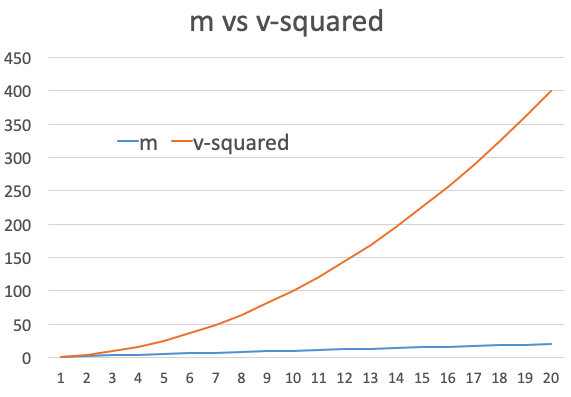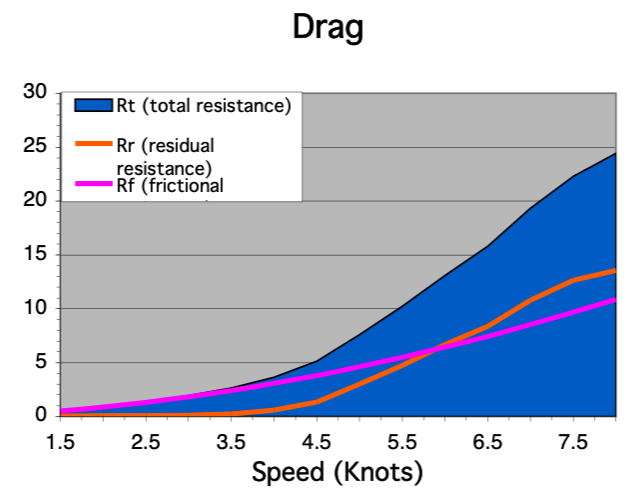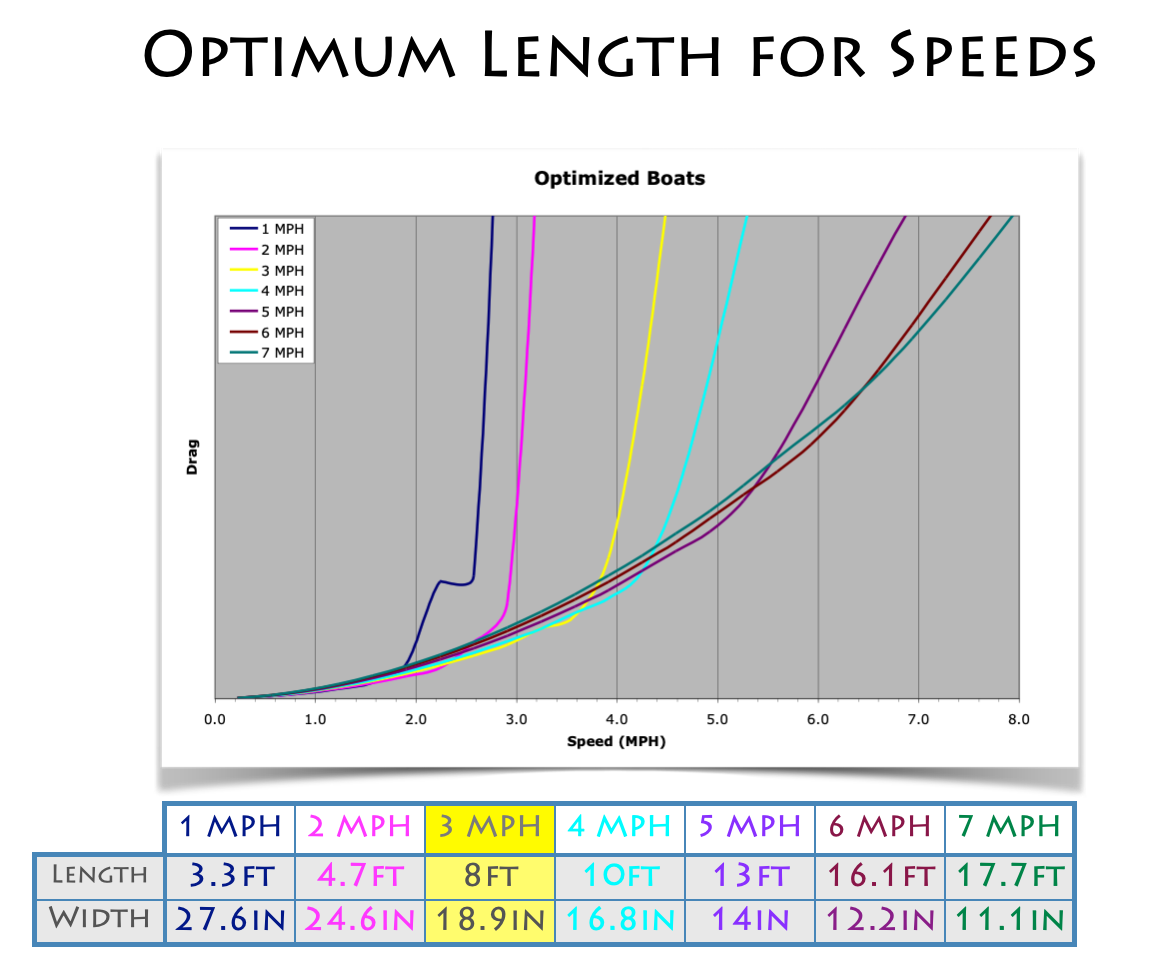Do You Really Need a Longer Kayak? – Kayak Plans
I often get questions to the effect of: “I have trouble keeping up with my friends, what kayak should I get?” Everyone knows that longer kayaks are faster, so obviously I should be recommending the longest kayaks I have to these folks.
But is it really true? Are longer kayak truly faster? Well, like a lot of things, the answer is: It Depends.
First we should talk a little bit about what makes a kayak fast or slow. You would think that if you hang a large enough outboard off the end, you should be able to make any pig take off. Within some limits this is true. What really determines how fast you go is how much power you can apply to your paddle. But different boats are going to go different speeds when you apply the same amount of power. What differentiates the boats is “drag”.
Drag is how much resistance the boat creates to oppose the power you are applying to make it go. Drag varies with speed, generally when you aren’t going very fast there isn’t a lot of drag and as you go faster and faster, the drag usually increases. What makes a slow boat vs a fast boat is how quickly the drag increases as speed increases.
Drag is created by two different forces, the frictional force of water trying to slide past the boat, and the force needed to accelerate the water away from the hull shape and back again as the boat splits through the water. These are called “Frictional Drag” and “Form Drag” respectively. Form drag is sometimes called “Residual” drag.
Friction with the water is created wherever the boat touches the moving water. The more boat touching the water, the more friction. This is often referred to as Wetted Surface Area or Wetted Area. For my designs you can find this in the Measurements section of each design or the design comparison page. As implied, a larger wetted area will result in more drag.
Form drag is a bit harder to understand. As you move your boat through still water, the hull must displace the water out of the way to make room for the boat, and after it has past, the water must move back in to fill the hole where the boat used to be. This requires accelerating the water out to the side and then back.
With wide boats, you need to move the water a long way out to the side and narrow boats, not so much so it is fairly easy to understand why narrow boats may have less drag. But what is the effect of length?
Think about lifting a heavy object to some height. You can either just grab ahold of it and lift it straight up, or roll it up a ramp to that height. Most people will agree that rolling it up a ramp will be easier, and the longer the ramp, the easier it is. While they both accomplish the same thing, trying to do the work all at once is more difficult than taking a little more time going up the ramp.
A longer boat works like a longer ramp. It accelerates the water more slowly, so the water doesn’t have to move as quickly to get out of the way, and likewise coming back together after the boat passes.
What may not be completely clear is why displacing the water slowly makes it easier. In the end, this all comes down to energy. Any energy you use to move water out of the way of the boat is energy that could be used to move the boat forward. I’m going to drop some math on you, but don’t get too tied up in the equation, just let me show you what the implications of the equation are.
The energy of a moving object is called Kinetic Energy or KE. The KE of an object is related to its weight or mass (m) and its speed or velocity (v). It is calculated with the following equation:
KE = 1/2 M V2
Let ignore the 1/2 bit. It doesn’t matter. Instead lets look at the two things we understand weight (m) and speed (v). In this equation, the weight is by itself just, where the speed has the little two over it meaning “squared”. So when we look at the contribution of mass to Kinetic Energy it is just the mass, but when we look velocity we need to multiply the velocity with itself. Lets see what that looks like in a graph:Image

If we look at the blue line for mass, the contribution to KE is just whatever the mass is. If you double the mass, the KE is doubled, ten times the mass, ten times the KE, but with the orange velocity curve, it is a completely different matter. Doubling the velocity means four times the KE, and 10 times the velocity means 100 times the KE.
So, if you take the math out of it just remember that small changes in weight means small changes in the energy while, small changes in the speed can result in significantly larger changes in the energy.
Looking at our short boat vs a long boat assuming they are the same width, if the boats weighs the same amount and the person paddling doesn’t change, the overall weight doesn’t change meaning its contribution to kinetic energy doesn’t change, but with a long boat, the speed at which you move the water is less because the same displacement of water happens along a greater length. If the long boat were twice as long as the short, you would only need about one quarter the energy to displace the water. Longer boats mean that for any given forward speed you paddle the boat, you end up moving the water sideways more slowly. This results in a savings in the amount of energy used to move the water.
Note that any energy applied to moving the water around the boat is visible in the form of the wake left by the boat. The boat wake is that energy moving away and lost. The act of your bow cutting through the waves creates a wave that continues after the boat has passed, another wave is created when the water slides back in behind the hull. These waves created by the boat moving through the water combine together to make the wake.
Given this, it would seem obvious that longer boats would always be faster. If you are putting less effort into moving the water out of the way, with a longer boat, that has to be a good thing. But longer boats come at a price. They generally have more wetted surface area. The shape with the lowest surface area is a round or spherical shape, when you start to stretch it out while keeping the volume the same, you end up increasing the surface area.
And remember that more surface area means more frictional drag. Looking at the graph of the velocity curve above, you can see that at the left side where the numbers are low, the orange curve takes a while before it really starts swinging upwards. The result of this slow start to the curve is that at low speeds the form drag doesn’t amount to much until your speed increases. At low speeds most of the drag on your boat is a result of the friction of the water rubbing against the hull.
The graph below is shows the drag of my Petrel design. The orange curve is the Form drag from the moving the water out way, and the magenta is the friction of water trying to slide over the surface. The blue area is from adding these two together. Notice that until about 3.5 knots, almost all the drag is just overcoming the friction and it isn’t until almost 6 knots that the Residual Form drag becomes the dominant factor.Image

A consequence of this is that at lower speeds short wide boats have less drag because of less wetted surface area and at higher speeds longer narrower boats do better. As an exercise in learning more about this I used a program called Michlet which is a hull drag modeler with a tool for creating “optimized” hull shapes for a given speed. Essentially I found an optimum length and width shape for a given speed, and then modeled the drag for that shape. So, the blue line shows the drag of a design with the minimum drag for 1 mile per hour. This resulted in a boat that was 3.3 feet long and 27.6 inches wide (shaped a bit like a lemon, round in the middle with some points at each end).Image

If you look carefully at the lower left side of the curve you can just make out that blue line just barely peeks out below all the other curves. It disappears around 1.5mph and then heads north hard past 2 mph, but at that point the magenta, 4.7′ x 24.6″ shape is showing below all others. If you were to take the drag number where the magenta curve crosses the 2 mph line and slide left to where that level crosses the green design optimized for 7 mph you will see that for the amount of effort it takes to make the 4.7′ long boat go 2 mph you the 17.7′ long 7-mph boat would only be going about 1.4 mph. The lower wetted surface area of the short boat is sufficient to make up for the fact that it will make a bigger wake at higher speeds.
This brings to light the very hard to fathom situation where the “slow” boat is faster than the “fast” boat when you are going slow. Whats more, notice that all the curves are headed up as you go to the right. Yes, the short designs optimized for slow speed gain drag faster, but there is no avoiding a gain in drag as you go faster. There may be funny little glitches in the curve like the blue at 2.4 mph where some weird interaction of hull wave forms briefly cancel out for a speed window of slightly reduced drag, but in general, it is all rapidly increasing drag as speed increases.
These boat dimensions may not be practical, but if you are in the 16.1′ design that is optimized for 6 mph and it takes everything you physically have to make it go 6 mph, getting a 17.7′ boat will not make you go faster. It may actually slow you down. You need to be substantially stronger to get the 17.7′ boat going fast enough for it to have an advantage over the 16.1′ design.
There really is no such thing as a fast kayak, there are only strong and fast paddlers. Hang a big enough engine off the stern, you can make any boat go fast. But, we are generally fairly weak weekend warriors, trying to get the best out of our old flabby bodies. How do we do it?
CONCLUSIONS
The “optimized” boats above are not realistic, if you are comfortable cruising along at 3 mph, you are going to be hard pressed to find an 8′ long boat that is 20″ wide. Most kayaks are wider than any of the above examples, but hopefully it makes you think about how you use your boat. Image

The above curve shows the drag of my Petrel vs my Petrel Play designs. The Petrel is 17′ x 20″ and the Petrel Play is 14′ x 23″, but the first thing to look at is the measurements comparison, notice that at the waterline the dimensions are 15′ x 19.9″ for the Petrel and 13.15′ x 22.75″ for the Petrel Play. Because of the more plumb bow of the “Play”, the waterline length (the part that matters) difference isn’t that stark. The Petrel Play also has less wetted surface area 18.7 sq ft vs 20.2 sq ft for the Petrel. And the overall surface area of the whole boat is less with the “Play”.
You can just make out a bit of blue showing below the purple below 2.5 knots, at 3 knots there is some divergence but it isn’t egregious. If you are paddling the Petrel Play in a typical group that averages about 3 knots (about 3.5mph or 5.6km/h) you are really giving up nothing to the 17′ long boats in the group. Yes, if they choose to sprint off you may struggle a bit, but you gain something as well. The lower total surface area of the Petrel Play means it doesn’t need as much material to build, which translates into a lighter boat. Longer boats also need to be structurally stronger meaning more weight. The shorter boat has less “swing weight” meaning less inertia when you want to turn, i.e. it is more responsive and quick turning. The shorter length fits the surface of choppy water better so it is more stable.
I have been paddling a composite version of my Petrel Play (made by Turning Point Boatworks) a lot recently. It is an exact copy of the strip built Play, just built from fiberglass and Innegra instead of wood strip. I’ve done 20 mile long distance paddles and a lot of playing in tide races and surf, paddling with friends in 17′ boats. I don’t feel that I have suffered from the shorter length. It is quick to get up to speed, easy to handle a lot of fun.
After years of watching people paddle all sorts of kayaks, I have come to the conclusion that for most paddlers 14′ of length is really all they need. I paddle long boats a lot as well from 17′ sea kayak to 20’+ surf skis. It takes a lot of strength, stamina and physical fitness to gain the speed potential advantages that longer boats offer. Short boats do tend to be wider which increases drag, but if you can find a reasonably narrow boat in the 14′ range, chances are that will be as fast as you will be comfortable paddling. Constantly seeking a longer boat to go faster will not do you any good if you don’t also spend the time to train and increase your fitness.
A short boat will be lighter, more responsive, easier to paddle most of the time, as well as easier to load on your car and store in your garage. There is absolutely a place for longer boats, but you may be surprised how happy you can be with something shorter.
0 Response to "Do You Really Need a Longer Kayak? – Kayak Plans"
Post a Comment